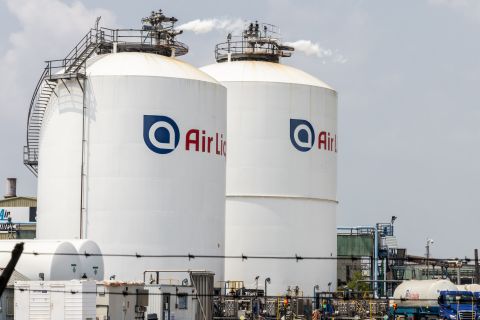When Wade Hutchings, Marathon Oil’s regional vice president of Midcontinent assets, joined the Oklahoma division two years ago, he questioned his team, “Do we really know the edges of the viable Woodford formation in the Stack or the SCOOP plays?”
While certain edges have been defined for each of these two central Oklahoma oil and wet gas targets over the past several years, “I would contend there are areas where we still don’t know the viable Woodford play. Although we know where today’s sweet spot is, I remain confident we will continue to grow the size and scale of these plays,” Hutchings told attendees at Hart Energy’s DUG Midcontinent conference in late February.
The stacked nature of the SCOOP and Stack plays is becoming an increasingly valuable forward driver for Marathon Oil—active for more than 100 years in Oklahoma—and its operated and nonoperated positions, he said.
The company holds some 175,000 acres prospective for the Woodford Shale, its primary target, and at least 63% of those acres have a stacked unconventional target sitting above them. “The stacked nature of these plays will provide numerous advantages to future play development and competitiveness,” Hutchings said.
Most prominently, the Springer Shale is prospective in the SCOOP region and the Meramec Shale in the Stack.
“We remain optimistic that several of our newer plays, the Meramec Shale and the Springer Shale, are emerging as viable economic targets and will become a more important part of our unconventional production growth in the years to come,” he said.
SCOOP complexities
Structural complexities in the SCOOP area can be considerable, Hutchings said, particularly in the northern portion of the Ardmore Basin that Marathon and others have recently targeted for Woodford production. A series of faults, sinklines and anticlines places the Woodford target at materially different depths and dips.
“Our ability to leverage 3-D seismic, the continued reprocessing of that seismic and integrating it with other subsurface information has been critical to successfully drill and complete the 12 wells in that area in the last year and a half,” Hutchings said.
All of the company-operated wells drilled in the northern Ardmore Basin part of SCOOP were 1,525-m (5,000-ft) laterals; six wells in the southern region ranged between 2,285 m and 3,050 (7,500 ft and 10,000 ft) in length.
“Where feasible, we continue to see a material economic uplift with extended laterals in many of these plays we’re targeting in Oklahoma,” Hutchings said. “We continue to drive higher per-well productivity in our operated SCOOP wells,” a 46% return on 30-day IPs year over year through 2014. Thirty-day IPs averaged above 1,000 boe/d for 2014.
“We’re now ready to move into development phase in the Woodford SCOOP and begin to test additional layers with the drillbit,” Hutchings said.
The company has been analyzing the Springer Shale for two years and plans to drill up to two operated wells—its first—in 2015.
Stack region
Moving north, the Stack region is starting to compete for capital in both drilling and leasing dollars as well, he said. “We continue to find ways to increase per-well productivity and to drill those wells cheaper and cheaper.”
Marathon made “material advances last year” in understanding the Meramec potential in its own wells and in partner wells. “It’s critical to drive further capital efficiency. As we compare well-cost improvements across all the plays we track, we have a lot higher potential for further improvements in the Oklahoma basins than anywhere else in our company’s portfolio,” he said.
Although the sweet spot today is in the rich-gas condensate window, he said, “I think we will find more and more of the SCOOP and Stack plays that are viable than we think today.”
Springer excitement
In the midst of 1,000-plus-bbl Woodford and Meramec well IPs in Oklahoma’s SCOOP and Stack plays, Springer shale potential is continuing to fascinate producers.
Newfield Exploration Co.’s Jarred 1-16H in Springer has an IP of 1,950 boe and had a 30-day average of 1,220 boe/d, 81% oil. Pat McCelvey, Newfield general manager, Midcontinent, said the company’s SCOOP, in which Springer is tucked, and its Stack are economic for Newfield at current oil prices. Newfield, which also operates in the Williston, Uinta and Arkoma basins, plans to spend 70% of its $1.2 billion 2015 capex budget on SCOOP and Stack.
As for Springer in particular, McCelvey told conference attendees, “We see it as a great addition to the SCOOP play…We’re excited about that.”
Breakeven prices
Brandon Mikael, a U.S. Lower 48 upstream analyst for Wood Mackenzie, told attendees that, within SCOOP to date, “your best Springer wells are not in the same place as your best Woodford wells.” Also, while “this is some of the best rock to drill in the Lower 48,” the areal extent is within a window smaller than the overall SCOOP-Woodford window. “It has limited running room,” he said. Even the core of the SCOOP play itself “has world-class rocks but just not much of them,” he said.
However, Wood Mackenzie reported earlier in February, based on Mikael’s findings, that SCOOP-Springer economics break even at $41 WTI, SCOOP-Woodford at $47, Bakken (Sanish and Parshall fields) at $45 and Eagle Ford (Karnes Trough) at $48.
“[SCOOP is] still one of the most exciting growth areas in the Lower 48 because of the stacked-pay potential,” Mikael said. He expects the Anadarko Basin’s SCOOP, Stack and Cana-Woodford production to exceed 1 MMboe/d by 2020, with about a fourth of that being oil and condensate. The estimate includes factoring for 60 rigs drilling these this year, down from 92 in 2014.
Newfield chairman, president and CEO Lee Boothby said in an earnings call that “there is attractive acreage out there, and there are people that control acreage that we view as attractive. [If] the market conditions and the timing are right, we’d like to add them to the portfolio.”
Newfield reported before the call that its SCOOP and Stack proved reserves are now 30% of its total 181-million-boe portfolio while, at 295,000 net acres, it is 23% of its leasehold. The company’s 10-operated-rig program in SCOOP and Stack, where its 2014 production doubled from 2013, is expected to produce up to 100 wells this year.
Recommended Reading
Air Products Sees $15B Hydrogen, Energy Transition Project Backlog
2024-02-07 - Pennsylvania-headquartered Air Products has eight hydrogen projects underway and is targeting an IRR of more than 10%.
Air Liquide Eyes More Investments as Backlog Grows to $4.8B
2024-02-22 - Air Liquide reported a net profit of €3.08 billion ($US3.33 billion) for 2023, up more than 11% compared to 2022.
SunPower Appoints Garzolini as Executive VP, Chief Revenue Officer
2024-03-14 - Tony Garzolini will oversee SunPower’s sales, including the direct, dealer and new homes channels, along with pricing and demand generation.
Bobby Tudor on Capital Access and Oil, Gas Participation in the Energy Transition
2024-04-05 - Bobby Tudor, the founder and CEO of Artemis Energy Partners, says while public companies are generating cash, private equity firms in the upstream business are facing more difficulties raising new funds, in this Hart Energy Exclusive interview.
Sherrill to Lead HEP’s Low Carbon Solutions Division
2024-02-06 - Richard Sherill will serve as president of Howard Energy Partners’ low carbon solutions division, while also serving on Talos Energy’s board.





